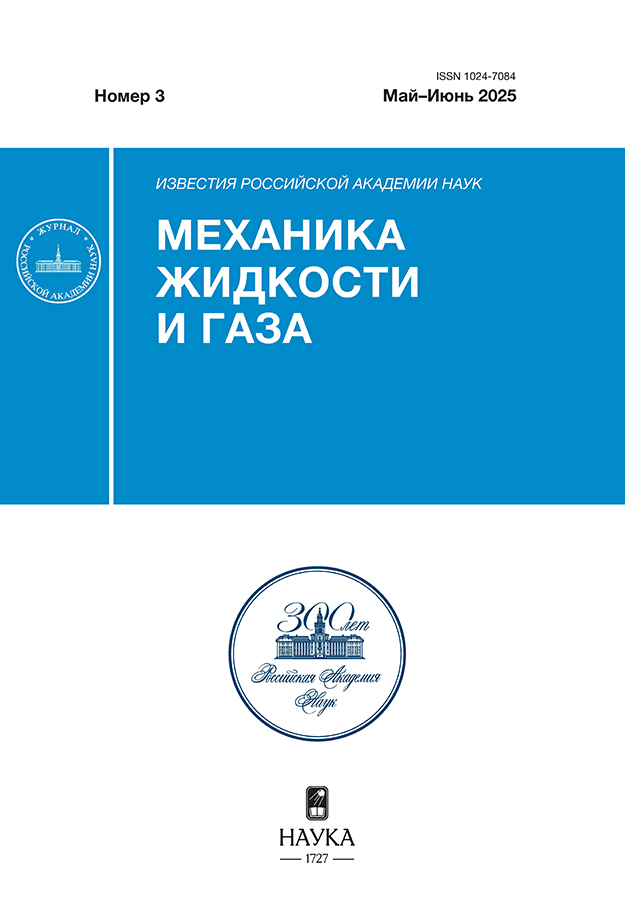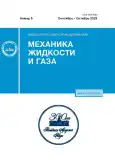Radiative characteristics of shock-heated air in the visible and infrared regions of the spectrum
- Authors: Kozlov P.V.1, Zabelinskiy I.E.1, Bykova N.G.1, Gerasimov G.Y.1, Levashov V.Y.1
-
Affiliations:
- Institute of Mechanics of Lomonosov Moscow State University
- Issue: No 5 (2023)
- Pages: 138-146
- Section: Articles
- URL: https://journals.rcsi.science/1024-7084/article/view/135112
- DOI: https://doi.org/10.31857/S1024708423600148
- EDN: https://elibrary.ru/TMYOVI
- ID: 135112
Cite item
Full Text
Abstract
The integral and temporal spectral characteristics of shock-heated air in the shock wave velocity range from 7.35 to 10.4 km/s at a pressure p0 = 0.25 Torr before the shock wave front were measured. The experiments were carried out on the DDST-M shock apparatus of the Moscow State University Institute of Mechanics. The radiation wavelength range = 600-1100 nm, corresponding to the visible and near-infrared spectral regions, in which the main contribution to the radiation is provided by atomic nitrogen and oxygen lines, was investigated. The analysis of the obtained integral in time spectrograms of radiation is performed. The peculiarities of time oscillograms for the most typical atomic lines of the spectrum are highlighted. The measurement data are compared with experimental data of other authors.
About the authors
P. V. Kozlov
Institute of Mechanics of Lomonosov Moscow State University
Email: levashovvy@imec.msu.ru
Moscow, Russia
I. E. Zabelinskiy
Institute of Mechanics of Lomonosov Moscow State University
Email: levashovvy@imec.msu.ru
Moscow, Russia
N. G. Bykova
Institute of Mechanics of Lomonosov Moscow State University
Email: levashovvy@imec.msu.ru
Moscow, Russia
G. Y. Gerasimov
Institute of Mechanics of Lomonosov Moscow State University
Email: levashovvy@imec.msu.ru
Moscow, Russia
V. Yu. Levashov
Institute of Mechanics of Lomonosov Moscow State University
Author for correspondence.
Email: levashovvy@imec.msu.ru
Moscow, Russia
References
- Wessen R.R., Propster P., Cable M. et al. Developing compelling and science-focused mission concepts for NASA competed mission proposals // Acta Astronaut. 2022. V. 191. P. 502–509.
- Leitner J., Hyde T. Modernizing NASA’s risk classification system // Acta Astronaut. 2023. V. 202. P. 333–340.
- Суржиков С.Т., Яцухно Д.С. // Анализ летных данных по конвективному и радиационному нагреву поверхности спускаемого марсианского космического аппарата SCHIAPARELLI // Изв. РАН. МЖГ. 2022. № 6. С. 73–84.
- Суржиков С.Т. Пространственная задача радиационной газовой динамики командного модуля Апполон-4 при сверхорбитальном входе в атмосферу // Из. РАН. МЖГ. 2018. № 2. С. 149–160.
- Uyanna O., Najafi H. Thermal protection systems for space vehicles: A review on technology development, current challenges and future prospects // Acta Astronaut. 2020. V. 176. P. 341–356.
- Колесников А.Ф., Васильевский С.А., Щелоков С.Л., Чаплыгин А.В., Галкин С.С. Анализ возможностей локального моделирования аэродинамического нагрева в мощном ВЧ-плазмотроне ВГУ-3 // Изв. РАН. МЖГ. 2022. № 6. С. 116–124.
- Reyner P. Survey of high-enthalpy shock facilities in the perspective of radiation and chemical kinetics investigations // Prog. Aerospace Sci. 2016. V. 85. P. 1–32.
- Brandis A.M., Johnson C.O., Cruden B.A. Investigation of non-equilibrium radiation for Earth entry // AIAA Paper 2016-3690. 19 p.
- Kozlov P.V., Surzhikov S.T. Nonequilibrium radiation NO in shocked air // AIAA Paper 2017–0157. 16 p.
- Gu S., Olivier H. Capabilities and limitations of existing hypersonic facilities // Prog. Aerospace Sci. 2020. V. 113. № 100607. 27 p.
- Герасимов Г.Я., Козлов П.В., Забелинский И.Е., Быкова Н.Г., Левашов В.Ю. Исследование радиационных характеристик высокотемпературных газов, проведенное в ударных трубах // Химическая физика. 2022. Т. 41. № 8. С. 17–30.
- Быкова Н.Г., Забелинский И.Е., Ибрагимова Л.Б., Козлов П.В., Стовбун С.В., Тереза А.М., Шаталов О.П. Радиационные характеристики воздуха в ультрафиолетовой и вакуумно ультрафиолетовой областях спектра за фронтом сильных ударных волн // Химическая физика. 2018. Т. 37. № 2. С. 35–41.
- Козлов П.В., Забелинский И.Е., Быкова Н.Г., Герасимов Г.Я., Левашов В.Ю. Экспериментальное исследование излучательных характеристик ударно-нагретого воздуха в ультрафиолетовой и видимой областях спектра // Изв. РАН. МЖГ. 2022. № 6. С. 85–93.
- Kozlov P.V., Zabelinsky I.E., Bykova N.G., Gerasimov G.Ya., Levashov V.Yu., Tunik Yu.V. Experimental study of air radiation behand a strong shock wave // Acta Astronaut. 2022. V. 194. P. 461–467.
- Cruden B., Martinez R., Grinstead J., Olejniczak J. Simultaneous Vacuum Ultraviolet through Near IR Absolute Radiation Measurement with Spatiotemporal Resolution in an Electric Arc Shock Tube // AIAA Paper 2009–4240. 13 p.
- Козлов П.В., Забелинский И.Е., Быкова Н.Г., Акимов Ю.В., Левашов В.Ю., Герасимов Г.Я., Тереза А.М. Развитие методики регистрации интенсивности излучения газов за фронтом сильных ударных волн // Химическая физика. 2021. Т. 40. № 8. С. 26–33.
- NIST Atomic Spectra Database, Version 5.10. Gaithersburg: NIST, 2022. https://doi.org/10.18434/T4W30F
- Kazakov V.V., Kazakov V.G., Kovalev V.S., Meshkov O.I., Yatsenko A.S. Electronic structure of atoms: atomic spectroscopy information system // Phys. Scr. 2017. V. 92. № 105002. 6 p.
- Brandis A.M., Johnston C.O., Cruden B.A., Prabhu D., Bose D. Uncertainty analysis and validation of radiation measurements for Earth reentry // J. Thermophys. Heat Trans. 2015. V. 29. P. 209–221.
- Jung Y.-D., Kim C.-G. Classical bremsstrahlung radiation from electron–ion encounters in a nonideal plasma // J. Plasma Phys. 2022. V. 67. P. 191–197.
- Lemal A., Jacobs C.M., Perrin M.-Y., Laux C.O., Tran P., Raynaud E. Prediction of nonequilibrium air plasma radiation behind a shock wave // J. Thermophys. Heat Trans. 2016. V. 30. P. 197–210.
- Суржиков С.Т. Расчет неравновесного излучения ударных волн воздухе с использованием двух моделей // Изв. РАН. МЖГ. 2019. № 1. С. 99–114.
- Brandis A.M., Cruden B.A. Benchmark shock tube experiments of radiative heating relevant to earth re-entry // AIAA Paper. 2017. № 2017–1145.
- Parker R., Dufrene A., Holden M., Wakeman T. Shock-front emission measurements at 10 km/s // AIAA Paper 2011–715. 11 p.
Supplementary files

















